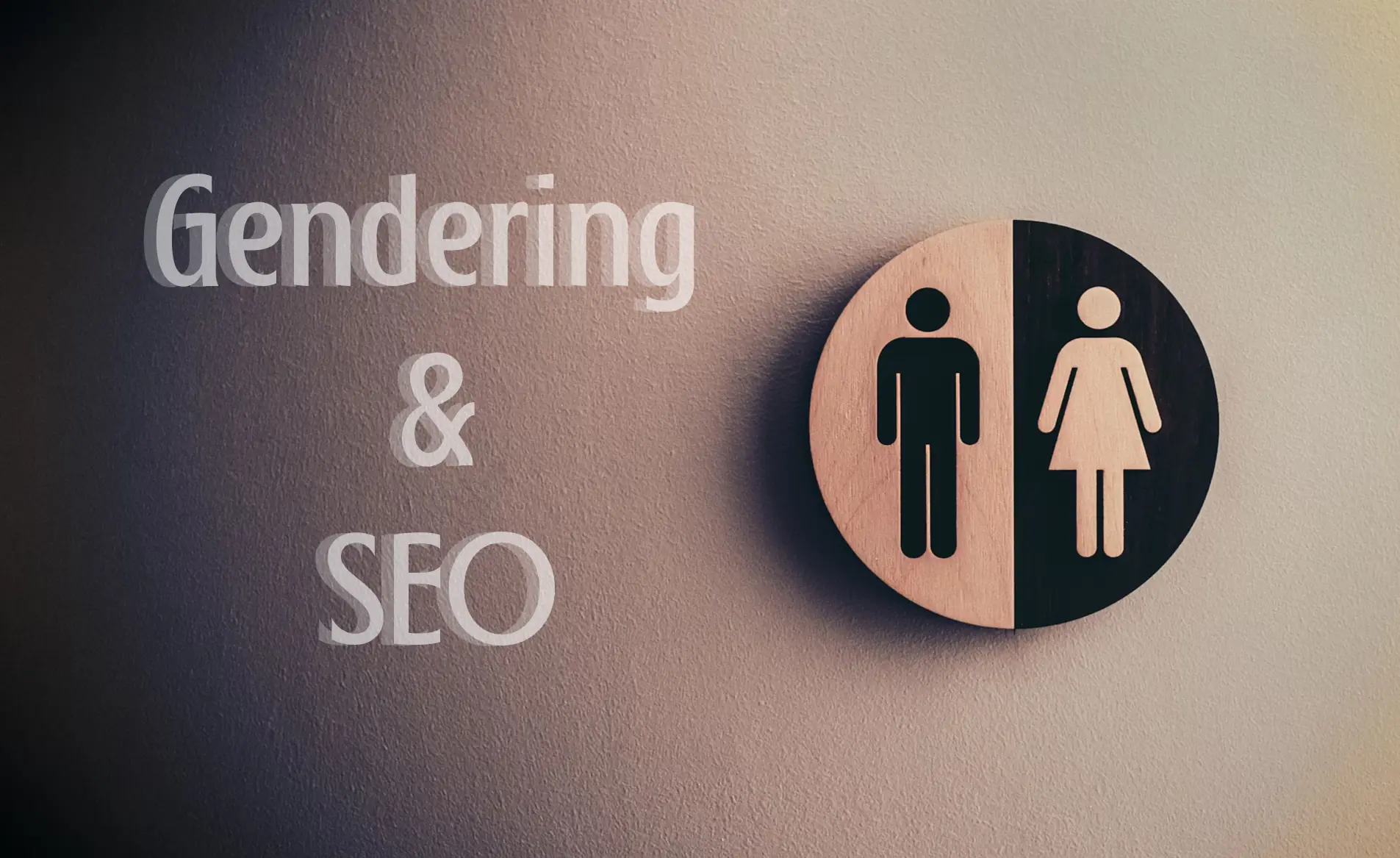Gender equality is becoming increasingly prevalent in language, including in companies, the press, and everyday life. So, it’s high time to address this topic in relation to SEO. In this blog post, I’ll show you to what extent gender-sensitive language can influence your rankings and your traffic, and what options you have to reconcile gender and SEO.
Let me clarify from the outset: I will not provide a recommendation for or against gendering on websites in this blog post. This is a personal decision that you, as a website owner, need to make yourself. In larger companies, the decision to use gender-sensitive language is also a strategic question that depends on the target audience and company culture.
When is gendering relevant for SEO?
Gendering impacts your SEO success when important main and secondary keywords refer to people. This is particularly relevant in areas dealing with professions and occupations, such as:
- Job ads
- Services, where users mostly search for people (doctors, craftswomen)
- Content that deals with occupational groups in general, for example, information about job descriptions
Conversely, this doesn’t mean that gendering is unimportant in other areas. As soon as your main or secondary keyword includes a person, the spelling plays a role—provided you are open to gender-sensitive spelling. (If you weren’t, you probably wouldn’t be reading this blog post. 😉)
Words in the body text of your content that are not SEO-relevant keywords, on the other hand, have little influence on SEO. For example, if you refer to “our employees” when introducing your company in a job ad, Google doesn’t really care.
Does Google distinguish the masculine and feminine forms in the SERPS?
Google’s algorithm is based on current user search behavior. This is the crux of the matter: the majority of Germans search for the masculine form, the so-called generic masculine, because it is easier and more common. This has more to do with the German language’s historical usage than with gender equality.
An example: If you are looking for a roofer, you probably don’t care whether it’s a woman or a man. You most likely (as I do, by the way) type “roofer” and possibly the location into the Google search bar.
Ideally, Google would recognize that the feminine and masculine forms of “roofer” fulfill the same search intent and reflect this in the SERPs. All genders would show up equally, and the results for “roofer,” “female roofer,” and “roofing company” would differ only minimally.
In reality, search engine results differ greatly between male and female spellings. In the case of “roofer,” it’s true that women and men are far from equal in the SERPs.
Male vs. female: basic patterns for keywords
Even though search queries must always be assessed individually on the basis of the target group and industry – some patterns can nevertheless be identified (as of today) for many keywords.
For the female spelling often, less pages are indexed
In the screenshot you can see this clearly: For the keyword “cameraman,” there are more than 7 million URLs in the Google index, but for “camerawoman,” there are only 429,000.
Keywords in the female form often have a lower search volume
As we can see from the overview of keywords in SEMrush, the keyword ‘female general practitioner’ has a much smaller search volume than ‘general practitioner.’ This disparity highlights how gender-specific searches can affect visibility and traffic. In SEO, understanding these nuances is crucial for creating inclusive and targeted strategies that cater to diverse audience needs.
For more insights on analyzing keyword metrics and improving your SEO strategy, check out our article.
Google suggests the masculine form
In many cases, Google seems to recognize what you are searching for in terms of content when you search for a “female” keyword. Nevertheless, the algorithm suggests to you: You surely meant the “male” search term.Of course, these are only rough patterns that do not apply equally to all keywords. But what does become clear: Google’s algorithm is far from keeping pace with the social change in language. Personally, I don’t judge this as misogynistic per se. In my opinion, Google search reflects the current search behavior of the majority of people.
However, I would like to see an algorithm that equates the masculine and feminine forms in terms of search intent and results pages. That this is possible is shown by the search results for keywords with the same search intent in the plural and singular – here search engines already recognize much better (although not always 
What Google itself says about this? The algorithm will adapt to the development of our language, in general one behaves with such things rather wait-and-see, so John Mueller in the SEO talk of June 10, 2021. As a further interesting contribution to listen to, I recommend the Search off the Record episode “Inclusive Language in Search” of December 7, 2021.
Gendering (almost) without SEO disadvantages: 7 tips
#1 Go for a broader keyword base
It definitely makes sense to think about gender-sensitive language as early as the keyword research stage. Freely research a wider range of alternative terms that fit your topic. In addition to gender dictionaries, it’s also worth brainstorming gender-neutral words as a team.
An example:
Let’s say you’re a restaurant owner looking for service staff. Here, possible search terms include not only “waiter” and “waitress,” but also “service staff,” “service specialists,” “waitresses,” “service support staff,” and “service employees.
For a comprehensive approach to keyword research that considers all these nuances, check out our keyword research service. We can help you uncover the best terms to boost your SEO strategy and ensure you reach a diverse audience.
#2 Analyze the SERPs and the competition before deciding on your main keyword.
At first glance, you might think: Great, my main keyword should be service. But a look at the search engine results will tell you otherwise, because for this keyword the top 5 dictionaries, Wikipedia and Co. rank
“Waiter” and “waitress” offer mixed results – but again, the job ads only come after Wikipedia, a rich snippet with headlines as well as similar questions.
A direct hit is the gender-neutral term “service person”, here Google plays out a Rich Snippet for job ads in first position:
Admittedly, this is a very thankful example – and: In the best case, of course, you check for each keyword, regardless of the gender aspect, whether the search intent fits your page. However, it shows that with a broad research you can find suitable gender-neutral keywords with search volume.
#3 Use the colon in H-headings and in the meta title.
It is more difficult when the SERPs are dominated by the male spelling with much larger search volume. And at the same time, the female and gender-neutral terms have no relevant search volume and the SERPs do not match your content focus. The best example is “roofer”: With the female spelling you currently have no chance of SEO success.
In this case, you can use the gender colon as a compromise: With “roofer:in” you choose the most promising keyword, since the male spelling is already included. At the same time, you use gender-sensitive language.
The main keyword should appear in the main heading (H1), the meta title and in a subheading (H2). In the text itself, you can use the feminine and masculine form alternately, gender throughout with a colon and, of course, use your broadly researched keyword base at the beginning.
#4 Weigh your decision if a colon or slash solution is not practical.
But: What do you do if the female spelling cannot be formed only by adding “-in” to words? Here you should weigh and decide based on the SERPs. Examples are:
- Doctor & Physician
- Expert & Expertess
- Nurse & nurse
If you find dictionaries, images and videos in top positions for your purely female search term in the SERPs and your competitors score exclusively with the male spelling, you have clear SEO disadvantages.
You run the risk of losing traffic and rankings if you completely omit the male keyword form in the meta title and H1. Since this usually has significantly more search volume, you lose potential reach at this point.
It is obvious to simply mention both forms in the meta title and in the H1. In principle, this is possible. But keep in mind that the space in the meta title is very limited. Especially with long words it becomes difficult. And a snippet with only two words in the title will have a negative impact on your click-through rate, for example with professions such as tax lawyer.
Ergo, all bad for women? Not in every case, because it is just as possible that you as a woman with the purely female keyword hit your target group much more accurately and achieve a much better conversion. For example, fewer people search for “female general practitioner”. There are currently just under 7 million pages in the Google index, for GP it is about ten times that: 70 million pages. For you, this means: less competition and a better fit of search content. Ergo: greater chances of a top ranking.
#5 Don’t overdo it with special characters in the text
For the user it is important to have an undisturbed reading flow. Here, too, you have an advantage if you have researched a broad keyword base. This way you can diversify the content. If many paragraphs contain phrases like “a good tax lawyer”, this limits the readability (especially in headlines) enormously. Moreover, this is also not inclusive, because read-aloud programs read this very haltingly with pauses – for people with visual impairments, this is quite annoying.
The good thing is that there is no rule that says you have to use gender colon, indented I, and slash throughout, or that you always have to mention male and female forms in the same passage. You can also, for example:
Use the genders symmetrically in the text – such as female and male employees or female and male internists and cardiologists.
use gender-neutral terms: Specialist for, family practice, employees, people who …
#6 Shift the focus from the subject to the object or activity.
Especially for informational content such as blog articles, it pays to change perspective and shift focus. Ask yourself: does my main keyword have to be a subject? Or can I rethink my approach linguistically?
For example, instead of titling your blog post “The most beautiful routes for hikers in the Alps”, you can use
the object: “The most beautiful hiking routes in the Alps” or
the activity: “Hiking in the Alps: The most beautiful routes”.
in the center.
This is not always easy and of course your options depend on the keyword focus. But in many cases, gender-appropriate spelling, readability and SEO can be reconciled.
#7 Test, try, analyze
Basically, you want to gender on your website? Then just start with some landing pages. No one expects the entire website to be gender-sensitive right away. What is important is the preparation – i.e. keyword research and SERP analysis. Observe over a period of time how these pages develop in terms of SEO performance. You can use the knowledge gained in this way for subsequent landing pages and approach your optimal version of the content step by step.
Quo vadis, Google? I personally believe that we need a gender update of the algorithm better today than tomorrow, so that the masculine and feminine spelling of words are equally weighted and recognized as synonyms. And so that the meaning of the generic masculine is truly reflected in the SERPs. But that will probably take a while – Google reacts to social developments more hesitantly than you might think.
Until then, you should be aware that Google’s gender bias will affect your SEO success when keywords involving people are involved. The more specifically you analyze the SERPs in advance and incorporate it into your keyword selection, the more likely you are to have no disadvantages and sometimes even advantages in SEO.
Whether the search behavior of people will change – I personally do not think so, respectively think that it will happen very slowly. In my eyes it is totally ok to search for “car mechanic” and not “female mechanic”. As long as both genders are finally represented equally in the search results and it is no longer a prerequisite for success to use the generic masculine in title and description. But that’s my personal opinion and there are certainly other attitudes out there.





